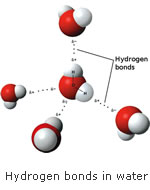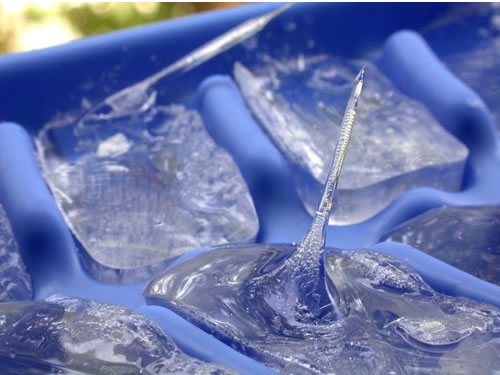
Water, good ol' H2O, seems like a pretty simple substance to you and me. But in reality, water - the foundation of life and most common of liquid - is really weird and scientists actually don't completely understand how water works.
Here are 5 really weird things about water:
1. Hot Water Freezes Faster Than Cold Water
Take two pails of water; fill one with hot water and the other one with cold water, and put them in the freezer. The hot one would be frozen before the cold one. But wait, you say, that's counterintuitive: wouldn't the hot water have to cool down to the temperature of the cold water before proceeding to freezing temperature, whereas the cold one has "less to go" before freezing?In 1963, a Tanzanian high-school student named Erasto B. Mpemba was freezing hot ice cream mix in a cooking class when he noticed that a hot mix actually froze faster than a cold mix. When he asked his teacher about this phenomenon, his teacher ridiculed him by saying "All I can say is that is Mpemba's physics and not universal physics."
Thankfully, Mpemba didn't back down - he convinced a physics professor to conduct an experiment which eventually confirmed his observations: in certain conditions, hot water indeed freezes before cold water*.
Actually, Mpemba was in good company. The phenomenon of hot water freezing first, now called the "Mpemba effect" was noted by none other than Aristotle, Francis Bacon and René Descartes.
But how do scientists explain this strange phenomenon? It turns out that no one really knows but there are several possible explanations, including differences in supercooling (see below), evaporation, frost formation, convection, and effects of dissolved gasses between the hot and cold water.
*In reality - of course - it's much more complex than that: hot water freezes first (it forms ice at a higher temperature than cold water), whereas cold water freezes faster (it takes less time to reach the supercooled state from which it forms ice) - see discussion on our previous blog post about this topic.
2. Supercooling and "Instant" Ice
Everybody knows that when you cool water to 0 °C (32 °F) it forms ice ... except that in some cases it doesn't! You can actually chill very pure water past its freezing point (at standard pressure, no cheating!) without it ever becoming solid.Scientist know a lot about supercooling: it turns out that ice crystals need nucleation points to start forming. These nucleation points could be anything from gas bubbles to impurities to the rough surface of the container. Without these things, water would continue to be a "supercooled" liquid well below its freezing point.
When nucleation is triggered, then a supercooled water would "instantly" turn into ice, as this very cool video clip by Phil Medina of MrSciGuy shows:
3. Glassy Water
 Quick:
how many phases of water are there? If you answer three (liquid, gas,
and solid) you'd be wrong. There are at least 5 different phases of liquid
water and 14 different phases (that scientists have found so far) of ice.
Quick:
how many phases of water are there? If you answer three (liquid, gas,
and solid) you'd be wrong. There are at least 5 different phases of liquid
water and 14 different phases (that scientists have found so far) of ice.Remember the supercooling we talked about before? Well, it turns out that no matter what you do, at -38 °C even the purest supercooled water spontaneously turns into ice (with a little audible "bang" no less). But what happens if you continue to lower the temperature? Well, at -120 °C something strange starts to happen: the water becomes ultraviscous, or thick like molasses. And below -135 °C, it becomes "glassy water," a solid with no crystal structure. (Source)
4. Quantum Properties of Water
At a molecular level, water is even weirder. In 1995, a neutron scattering experiment got a weird result: physicists found that when neutrons were aimed at water molecules, they "saw" 25% fewer hydrogen protons than expected.Long story short, at the level of attoseconds (10-18 seconds) there is a weird quantum effect going on and the chemical formula for water isn't H2O. It's actually H1.5O! (Source)
5. Does Water Have Memory?
 In
the alternative medicine of homeopathy, a dilute solution of a compound
In
the alternative medicine of homeopathy, a dilute solution of a compound
This made no sense to Madeleine Ennis, a pharmacologist and professor at Queen's University in Belfast, Northern Ireland. Ennis, who also happened to be a vocal critic of homeopathy, devised an experiment to disprove "water memory" once and for all - but discovered that her result was the exact opposite!
In her most recent paper, Ennis describes how her team looked at the effects of ultra-dilute solutions of histamine on human white blood cells involved in inflammation. These "basophils" release histamine when the cells are under attack. Once released, the histamine stops them releasing any more. The study, replicated in four different labs, found that homeopathic solutions - so dilute that they probably didn’t contain a single histamine molecule - worked just like histamine. Ennis might not be happy with the homeopaths’ claims, but she admits that an effect cannot be ruled out.So far, other scientists failed to reproduce Ennis' experimental findings (throughout, Ennis herself was skeptical of the result's interpretation that water has a "memory" but maintained that the phenomenon she saw was real).
So how could it happen? Homeopaths prepare their remedies by dissolving things like charcoal, deadly nightshade or spider venom in ethanol, and then diluting this "mother tincture" in water again and again. No matter what the level of dilution, homeopaths claim, the original remedy leaves some kind of imprint on the water molecules. Thus, however dilute the solution becomes, it is still imbued with the properties of the remedy.
You can understand why Ennis remains skeptical. And it remains true that no homeopathic remedy has ever been shown to work in a large randomised placebo-controlled clinical trial. But the Belfast study (Inflammation Research, vol 53, p 181) suggests that something is going on. "We are," Ennis says in her paper, "unable to explain our findings and are reporting them to encourage others to investigate this phenomenon." If the results turn out to be real, she says, the implications are profound: we may have to rewrite physics and chemistry. (Source)
See also Jacques Benveniste's Nature controversy | Louise Rey's thermoluminescence study
More recently, a team of scientists at the University of Toronto, Canada, and Max Born Institute in Germany, studying water dynamics using fancy multi-dimensional nonlinear infrared spectroscopy did find that water have a memory of sorts - in form of hydrogen bond network amongst water molecules. Problem for homeopathy was, this effect lasted only 50 femtoseconds (5 x 10-14 seconds)!
Bonus: Ice Spikes
Ice spikes are, well, spikes that grow out of ice cube trays. They look like stalagmites found in caves, and you can make 'em yourself using distilled water. Kenneth G. Libbrecht of SnowCrystals explains:How do Ice Spikes Form?
Ice spikes grow as the water in an ice cube tray turns to ice. The water first freezes on the top surface, around the edges of what will become the ice cube. The ice slowly freezes in from the edges, until just a small hole is left unfrozen in the surface. At the same time, while the surface is freezing, more ice starts to form around the sides of the cube.
Since ice expands as it freezes, the ice freezing below the surface starts to push water up through the hole in the surface ice (see diagram). If the conditions are just right, then water will be forced out of the hole in the ice and it will freeze into an ice spike, a bit like lava pouring out of a hole in the ground to makes a volcano. But water does not flow down the sides of a thin spike, so in that way it is different from a volcano. Rather, the water freezes around the rim of the tube, and thus adds to its length. The spike can continue growing taller until all the water freezes, cutting off the supply, or until the tube freezes shut. The tallest spike we've seen growing in an ordinary ice cube tray was 56mm (2.2in) long. (Source)
Bonus 2: Make Instant Snow with Boiling Water
What do you get when you throw boiling water to the air in subzero weather? Instant snow. Interestingly, it only works with boiling hot water:These aren't the only things weird about water. We didn't talk about how water density changes with temperature (ice, for instance, is less dense than water so it floats - a key property of water that made life possible in the oceans and lakes). Nor did we talk about the weirdly strong surface tension of water, ordered clustering of liquid water, and so on. If you are interested, check out the Anomalous Properties of Water article by Martin Chaplin
Semoga artikel ini bermanfaat. Jika ingin mengutip, baik itu sebagian atau keseluruhan dari isi artikel ini harap menyertakan link dofollow ke http://most-unique-things.blogspot.com/2013/01/5-really-weird-things-about-water.html. Terima kasih telah membaca artikel ini.
















0 comments:
Post a Comment